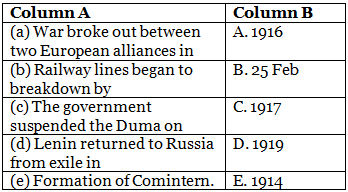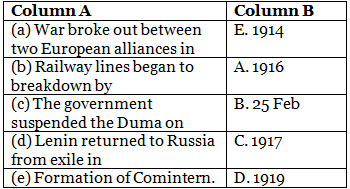Class 9 History Chapter 2 Practice Question Answers - Socialism in Europe and the Russian Revolution
| Table of contents |

|
| Multiple Choice Questions (MCQs) |

|
| Fill in the blanks |

|
| True/False |

|
| Matching Questions |

|
Multiple Choice Questions (MCQs)
Q1: Who were Jadidist ?
(a) They were social reformers
(b) They were Revolutionary
(c) They were Christians
(d) The were Muslim reformers within Russian Empire.
Ans: (d)
The Jadidists were a group of Muslim reformers in the Russian Empire who sought to modernize Islamic education and society.
Q2: Who were the Kulaks?
(a) Workers of Bolshevik Party
(b) Workers of Menshevik Party
(c) Group of army leader
(d) Well-to-do peasants
Ans: (d)
Kulaks were wealthier peasants in Russia who owned larger farms and were often targeted during collectivization.
Q3: Which of the following statements are true about Marfa Vasileva?
(i) She was a brave mill worker
(ii) She was a milling machine operator
(iii) She single handled organised a successful strike
(iv) She was a typical Russian housewife.
(a) (i) and (ii)
(b) (i) and (iv)
(c) (i), (ii) and (iii)
(d) All are correct.
Ans: (c)
Marfa Vasiteva was a brave mill worker and a milling machine operator who single handled organised a successful strike.
Q4: What was the status of Non- Russian nationalities before 1917 Russian Revolution.
(i) They had equal status
(ii) They were treated as inferiors
(iii) They were given equal rights
(iv) They were not allowed to practise their own language and culture
(a) (i) and (ii)
(b) (iii) and (iv)
(c) (ii) and (iv)
(d) (i) and (iii)
Ans: (c)
Before 1917 Russian Revolution, the status of Non-Russian nationalities were treated as inferiors and were not allowed to practice their own language and culture.
Q5: Who started collectivisation?
(a) Lenin
(b) Czar II
(c) Stalin
(d) Rusputin
Ans: (c)
Stalin initiated the policy of collectivization to consolidate individual land and labor into collective farms.
Q6: Who is the author of the book ‘The History of a Soviet Collective Farm’?
(a) Fedor Belov
(b) V.Sokalov
(c) S.D. Vidyalanker
(d) R.S. Avasthi
Ans: (a)
‘The History of a Soviet Collective Farm’ was written by Fedor Belor.
Q7: What was the slogan of the Bolshhvik Party which brought it into power in Russia ?
(a) All powers to the Soviets
(b) All powers to the Czar
(c) All powers to the Duma
(d) All powers enjoyed by middle class
Ans: (a)
The Bolshevik Party wanted all powers to exist between the Soviets and thus, their slogan was ‘All powers to the Soviets.
Q8: When did Russian Czar, Nicholas II resign?
(a) On March 3, 1917
(b) On Feb. 2, 1917
(c) On March 2, 1917
(d) On Feb. 4, 1917
Ans: (c)
On March 2, 1917 due to pressure for the people the Russian Czar, Nicholas II, resigned.
Q9: Russia decided to withdraw from World War I because:
(i) People were demanding peace.
(ii) A civil war was going on in Russia.
(iii) Russia had lost lot of manpower.
(iv) It was against imperialism.
(a) (i) and (iv)
(b) (i) and (iii)
(c) All (i), (ii), (iii) and (iv)
(d) All are not the correct reasons.
Ans: (c)
Russia withdrew from World War I because it was demanding peace, had many casualties, was against imperialism and a civil war was taking place in Russia.
Q10: What are the features of the Communist International?
(i) It was formed to promote Socialist Revolution on an international scale.
(ii) It was decided the policies to be pursued and laid them down for worldwide acceptance.
(iii) The section of the socialist party which were more radical and progressive organised themselves into common interest
(iv) It was formally ended in 1943
(a) (i) and (iv) are correct
(b) (i) and (iv) are correct
(c) (i) and (iii) are not correct
(d) All are correct
Ans: (d)
The Communist International had all the above features. They were also called as the third International or Comintern.
Fill in the blanks
Q11: The __________ Party was renamed as the Russian Communist Party.
Ans: Bolsheviks
The political party known as the Bolsheviks, which was led by Vladimir Lenin during the Russian Revolution, was later renamed the Russian Communist Party. This was due to the Bolshevik's adherence to the principles of Marxian communism, which they sought to implement in Russia after overthrowing the existing Tsarist regime.
Q12: During 1918 and 1919, the __________ and __________ armies controlled most of the Russian Empire.
Ans: ‘Green’, ‘White’
During the years 1918 and 1919, the ‘Green’ and ‘White’ armies controlled most of the Russian Empire. These were the forces opposed to the Bolsheviks (Red Army), with the 'White' referring to anti-communist forces and the 'Green' referring to peasant armies. The control of these armies over most of Russia indicates the widespread resistance to the Bolsheviks during this period.
Q13: Centralised planning led to __________ growth.
Ans: Economic
Centralised planning, a key feature of the economic system implemented by the Bolsheviks, led to economic growth in Russia. Under this system, the state controlled and directed all economic activity with the aim of ensuring the most efficient use of resources and the achievement of specific economic and social goals.
Q14: When the Bolsheviks ordered land redistribution, the __________ army began to break up.
Ans: Russia
When the Bolsheviks, now the Russian Communist Party, ordered land redistribution, the Russian army began to disintegrate. This was because the redistribution of land was a significant move towards communism, and many members of the army, particularly the officers, were opposed to this political ideology.
Q15: In __________, Bolshevik colonists brutally massacred local nationalists in the name of defending __________.
Ans: Khiva, Socialism
In a region called Khiva, Bolshevik colonists brutally massacred local nationalists in the name of defending Socialism. This act of violence was part of the Bolsheviks' efforts to suppress any opposition to their rule and their policies, which were aimed at establishing a socialist state in Russia.
True/False
Q16: The radicals wanted a nation in which government was based on the majority of a country’s population.
Ans: True
The Radicals wanted a nation where the government was based on the majority of the population. This is because they believed that governments should represent the voice and interests of the majority. They advocated for the system of universal adult franchise, where every adult citizen of the country, irrespective of their social or economic backgrounds, had the right to vote, thereby ensuring maximum representation.
Q17: Industrialisation brought men, women and children to factories.
Ans: True
Conservatism was a political philosophy that sought to preserve the traditional social order and institutions. On the other hand, radicals and liberals wanted changes in society and governance. They advocated for concepts like freedom, equality, and fraternity, which were seen as a threat to the traditional social order by the conservatives. Hence, conservatives were opposed to radicals and liberals.
Q18: In France, Italy, Germany and Russia, some nationalists became revolutionaries and worked to overthrow the existing dictatorship.
Ans: False
In France, Italy and Germany, nationalists did indeed become revolutionaries and worked to overthrow existing monarchies and establish democratic governments. However, in Russia, the situation was different. The revolutionaries there aimed to overthrow the Tsarist autocracy, but they were not nationalists in the same sense as in Western Europe. They aimed to create a socialist society, not a nation-state.
Q19: Conservatives were not opposed to radicals and liberals.
Ans: False
Conservatism was a political philosophy that sought to preserve the traditional social order and institutions. On the other hand, radicals and liberals wanted changes in society and governance. They advocated for concepts like freedom, equality, and fraternity, which were seen as a threat to the traditional social order by the conservatives. Hence, conservatives were opposed to radicals and liberals.
Q20: Opposed to the privileges the old aristocracy firmly believed in the value of individual effort, labour and enterprise.
Ans: True
The statement refers to the Liberals. They opposed the privileges that the old aristocracy enjoyed and firmly believed in the value of individual effort, labour and enterprise. They argued for a society where opportunities were available to individuals based on their talent and hard work, rather than their birthright. This belief was in line with the emerging middle-class during the Industrial Revolution.
Matching Questions
Q21:

Ans:
Q22:  Ans:
Ans:
FAQs on Class 9 History Chapter 2 Practice Question Answers - Socialism in Europe and the Russian Revolution
| 1. What were the main causes of the Russian Revolution? |  |
| 2. How did socialism influence the Russian Revolution? |  |
| 3. What was the significance of the October Revolution in 1917? |  |
| 4. What were the main features of socialism practiced in Europe during the late 19th and early 20th centuries? |  |
| 5. How did the Russian Revolution impact the rest of the world? |  |




















